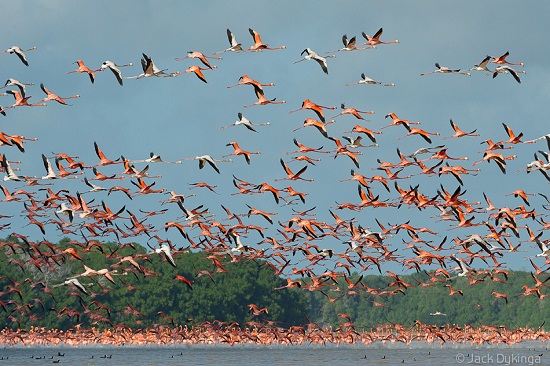Mexico, (EFE).-The flamingos migratory route, which was unknown for the specialists until now, will be finally possible to track in México, thanks to state-of-the-art satellite transmitters, this was informed by the Secretariat of Environmental and Natural Resources (Semarnat).
The Semarnat explained that satellite transmitters were affixed to five specimens of Caribbean or Pink flamingo (Phoenicopterus ruber), three females and two males, that were taken from the Ría Lagartos Protected Natural Area located in the northeastern coast of Yucatan.
It was explained that this technology will allow to obtain information on the timing (exact dates) and the migratory route of the species.
The Secretariat of Environmental and Natural Resources also said that they will continue with the marking of young specimens, from which specialists will be obtaining additional information such as their longevity. Besides, they will be able to learn more about the flamingos’ behavior throughout the coastal wetlands of the Yucatan Península.
Semarnat experts pointed out that the flight of the flamingo has been a research topic for many years and pointed out that “the extent of the distances traveled beyond the Mexican coastlines and the routes followed across the Caribbean islands are still unknown.”

Greater flamingos in the Ria Celestun Biosphere Reserve, Yucatan state, Mexico (PHOTO: Google)
The National Commission of Natural Protected Areas (Conanp), the Pedro and Elena Hernández Foundation (FPEH), and the South Border College (Ecosur) were the institutions in charge of this initiative.
The Ría Lagartos Natural Protected Area, located within the state of Yucatan, represents the main nesting spot for the Caribbean flamingo in Mexico and corresponds to the coastal wetlands of the Biosphere Reserve of the same name.
The Conanp indicated that in the terms of species conservation, significant work has been carried out with actions such as the restoration of nesting areas, the identification of young flamingos and the constant monitoring of their behaviour. It also pointed out that the currently movement of the flamingos is associated with climate change and fluctuations in water levels in their areas of food and reproduction.
Given that the species are distributed along the coast of the Yucatan Peninsula, flamingos´behavior is a significant indicator of priorities in the conservation work of coastal wetlands.
Source: http://www.trt.net.tr/

